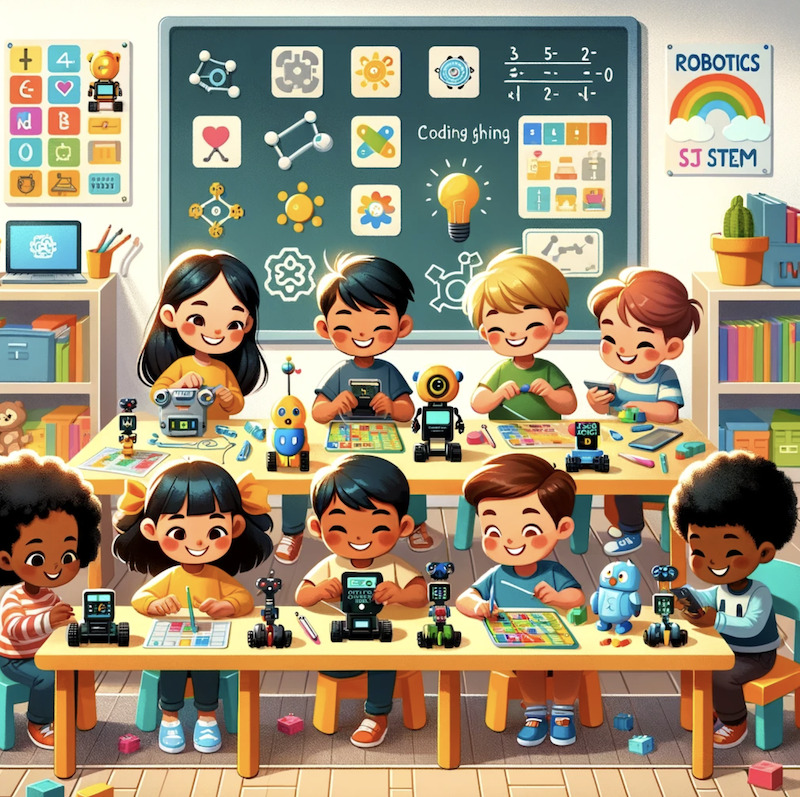Are you looking to introduce your young learners to the fascinating world of STEM (Science, Technology, Engineering, and Mathematics)? Incorporating robotics along with the right curriculum can be a game-changer. Here’s a guide to help you navigate this exciting journey!
Why Choose Robotics for STEM Education?
- Engagement: Robots are inherently engaging and interactive, making learning fun and memorable for kids.
- Hands-On Learning: Robotics provides a tangible way for children to grasp complex concepts, improving their understanding and retention.
- Foundation for Future Learning: Early exposure to STEM through robotics lays a strong foundation for advanced learning in later years.
Choosing the Right Robot for K-2
When selecting a robot for your K-2 education, consider age appropriateness, educational value, and ease of use. Popular choices include:
- Bee-Bot: Great for the youngest learners with simple programming features.
- mTiny: Offers a screen-free coding learning experience, perfect for reducing digital exposure and introducing coding.
- Dash Robot: Known for its durability and engaging activities, suitable for kids slightly older within the grade 1-3 range using a tablet or phone for coding.
- LEGO Boost Creative Toolbox: Combines the fun of LEGO with the basics of coding and robotics.
- Ozobot: Offers versatile programming capabilities for several grade ranges using a tablet or phone for coding.
Integrating Curriculum and Books
While robots provide practical experience, curriculum guides and books are crucial for structured learning. They offer lesson plans, project ideas, activity sheets, and educational content tailored to young minds.
Introduce Coding with Robots
A fantastic way to introduce your K-2 learners to coding is through the use of coding cards and block-based coding systems. These tools break down coding concepts into understandable and visually engaging segments, making them ideal for young minds. Coding cards, often used with robots like mTiny and Bee-Bot, feature simple instructions and symbols, allowing children to plan a sequence of movements that the robot will follow. This not only teaches the basics of algorithmic thinking but also enhances problem-solving skills.
Integrating these tools with your STEM curriculum provides a balanced approach to learning. It combines the tactile experience of physically arranging cards with the dynamic and interactive nature of digital coding, ensuring that your child receives a well-rounded introduction to the fundamentals of coding. This early exposure not only builds a strong foundation for future learning but also fosters critical thinking and creativity.
Cost Considerations
When looking only at the robots, without any add-ons or curriculum, here is a cost comparison:
- Low-Cost: Bee-Bot ($60 – $100) and mTiny ($100 – $130)
- Mid-Cost: Dash Robot ($150)
- High-Cost: LEGO Boost Creative Toolbox ($160) and Ozobot ($175)
The estimated cost for a comprehensive K-2 STEM curriculum, including robotics and educational materials, ranges from $200 to $1,200+. This variance depends on the resources you choose and how you balance between free online content and purchased materials.
Maximizing Your Investment
- Blend Free and Paid Resources: Utilize free online resources, library books, and community groups to complement purchased materials.
- Choose Bundled Resources: Choose packages where the curriculum is bundled with the robot to gain maximum value. Review a lesson.
- Choose Reusable and Durable Resources: Investing in quality materials that can be reused for other students or future lessons is cost-effective in the long run.
- Involve the Child in the Learning Process: Allowing the child to participate in choosing the robot or projects can increase their interest and engagement.
Implementing the Curriculum
- Start with Basics: Introduce basic concepts before diving into complex projects.
- Encourage Creativity: Let your child experiment and explore different ways to use the robot.
- Incorporate Cross-Disciplinary Learning: Use robotics to teach math, science, and even art, enhancing the learning experience.
- Be Patient and Flexible: Each child learns differently. Be ready to adapt your teaching methods to their unique learning style.
Ignite a Passion for Learning
Integrating robotics into your curriculum for K-2 learners is not just about teaching coding or engineering; it’s about igniting a passion for learning and exploration. With the right resources and approach, you can provide your child with an invaluable educational experience that sets them on a path of curiosity and innovation.
Remember, the goal is to foster a love for learning and discovery. So, embark on this journey with an open mind and a willing heart.
Discover the Perfect STEM Resources for Your Early Learner
As you embark on this enriching educational journey, remember that you’re not alone. EDforTech specializes in providing top-notch robots and curriculum specifically designed for Grades K-2. Our team of STEM specialists are experts in crafting engaging, interactive lessons that incorporate robotics, making learning both fun and impactful for your little ones. With our carefully curated resources and expert guidance, you’ll have everything you need to spark a lifelong love for STEM in your children.
Reach out to us to explore our range of products and tap into the expertise of our STEM specialists, and watch your child’s imagination and skills soar with the help of our engaging robotic lessons. 🌟🤖📚

